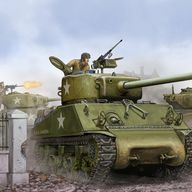Due to the sheer surplus of M4 Shermans available to the United States during World War II, a great number of separate tank battalions were formed; these were typically assigned to infantry divisions to grant frontline troops permanent armoured support, a luxury which their Comintern opponents never possessed.
The M4A3 Sherman is derivative of the M4 Sherman with a number of improvements. It standardizes on the baseline M4's welded hull, uses the more powerful Ford GAA engine and has an HVSS system which better distributes weight, allowing for more gentle rides through harsh terrain. However, the most important advancement in the M4A3 comes from its most widely produced version by far, the M4A3 (76) W, which includes wet stowage and a 76mm Gun M1 cannon with a reinforced gun mantlet. This version is also known as the M4A3E8 and it proved to be decisive in the Eastern Front, as the "Easy Eights" could reliably put up a fight against waves of Soviet armour.
